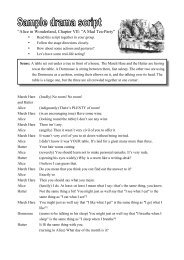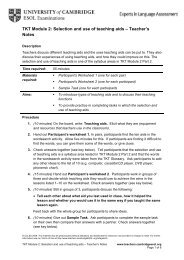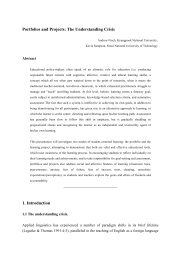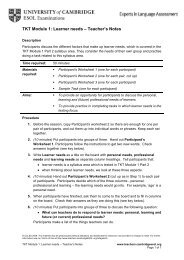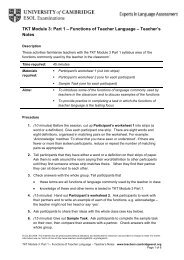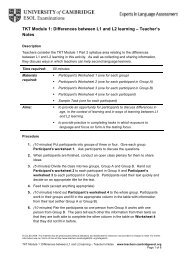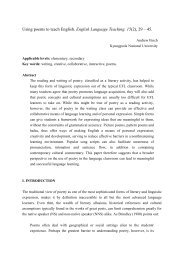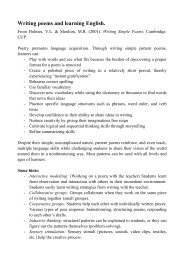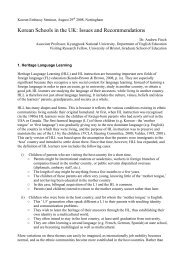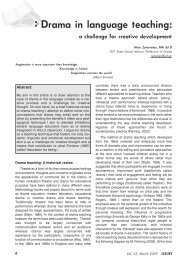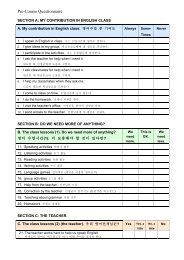Describing language: Phonology â Teacher's Notes - Finchpark
Describing language: Phonology â Teacher's Notes - Finchpark
Describing language: Phonology â Teacher's Notes - Finchpark
You also want an ePaper? Increase the reach of your titles
YUMPU automatically turns print PDFs into web optimized ePapers that Google loves.
TKT Module 1: <strong>Describing</strong> <strong>language</strong>: <strong>Phonology</strong> – Teacher’s <strong>Notes</strong><br />
Description<br />
Participants explore the different aspects of phonology which may be tested in TKT Module<br />
1 Part 1. As well as covering phonetic symbols, they will become more familiar with features<br />
of pronunciation at word and connected speech levels. There is also a TKT-type task for<br />
them to complete.<br />
Time required:<br />
Materials<br />
required:<br />
60 minutes<br />
• Participant’s Worksheet 1 (cut into strips)<br />
• Participant’s Worksheet 2 (one for each participant, plus the chart<br />
cut up)<br />
• Participant’s Worksheet 3 (one for each participant)<br />
• Participant’s Worksheet 4 (one per pair)<br />
• Participant’s Worksheet 5 (one for each participant)<br />
• Sample Task (one for each participant)<br />
Aims: • To familiarise participants with symbols form the International<br />
Phonetic Alphabet (IPA).<br />
Procedure<br />
• To provide and opportunity for participants to discuss word stress,<br />
sentence stress, intonation and connected speech.<br />
• To provide practice in completing tasks in which phonology is the<br />
testing focus.<br />
1. Before the session, cut up Participant’s worksheet 1 into strips so there are enough<br />
for one per participant. Repeat the strips if necessary.<br />
Make one copy for every 20 participants of the phonemic chart on Participant’s<br />
worksheet 2 and cut it into individual symbols. You will also need further copies of<br />
Participant’s worksheet 2 (uncut) for each participant.<br />
2. (10 minutes) Give each participant a strip from Participant’s worksheet 1.<br />
Participants walk around the room asking their question until they find someone who<br />
answers yes. They should then get some more detail from the person. For example,<br />
follow-up questions for Find someone in the room whose favourite colour<br />
contains the sound /u/. could be What is your favourite colour or Why do you like<br />
that colour so much Participants should make a note of the answers to their<br />
question.<br />
3. When participants have finished, feed back with the whole group for them to share<br />
information. Then ask participants:<br />
• What kind of activity was this (warmer, getting to know you activity)<br />
• Did all of the questions have a particular <strong>language</strong> focus (yes, phonology)<br />
© UCLES 2009. This material may be photocopied (without alteration) and distributed for classroom use provided no charge is made. For further<br />
information see our Terms of Use at http://www.teachers.cambridgeESOL.org/ts/legalinfo<br />
TKT Module 1: <strong>Describing</strong> <strong>language</strong>: <strong>Phonology</strong> – Teacher’s <strong>Notes</strong><br />
www.teachers.cambridgeesol.org<br />
Page 1 of 9
• What aspects of phonology were raised in the questions (sounds and word<br />
stress)<br />
• How are sounds categorised in the phonemic chart (consonants, vowels and<br />
diphthongs (two single vowel sounds combined to make a new sound))<br />
4. (15 minutes) Put participants into four groups; Group A, Group B, Group C and<br />
Group D. Give each group 11 of the phonemic symbols from the chart on<br />
Participant’s worksheet 2. Hand out Participant’s worksheet 2. Each group should<br />
match their symbols with letters underlined in the words in the table.<br />
5. When participants have finished, regroup them so that they form new groups of four,<br />
each with a member of Group A, Group B, Group C and Group D. Participants share<br />
their answers.<br />
6. Hand out Participant’s worksheet 3 to check answers.<br />
7. Tell participants that candidates’ knowledge of the symbols from the International<br />
Phonetic Alphabet (IPA) is tested in TKT Module 1 Part 1 under the syllabus area<br />
relating to phonology within ‘concepts and terminology for describing <strong>language</strong>’. Ask<br />
participants<br />
• What other areas of phonology do you think are tested in this syllabus<br />
area (word stress, sentence stress, intonation and connected speech)<br />
8. (10 minutes) Hand out Participant’s worksheet 4. Participants work in pairs and put<br />
the 15 words into 4 categories based on which syllable in each word carries the main<br />
stress. They should write the word in the appropriate column in the table.<br />
9. Check answers together (see key below). Ask participants:<br />
• How can you find out which syllable carries the main stress (dictionaries<br />
have this noted with a symbol on the entry)<br />
10. (10 minutes) Give out Participant’s worksheet 5. Participants match the features of<br />
phonology in the box with the underlined sections of the sentences. Check answers<br />
(see key below).<br />
11. (10 minutes) Give out Sample Task. Participants complete the sample task on their<br />
own then compare their answers with a partner. Check answers together (see key<br />
below).<br />
12. (5 minutes) Round up to summarise points covered. Ask participants:<br />
• What is the TKT Module 1 syllabus area for this lesson (concepts and<br />
terminology for describing <strong>language</strong> – phonology)<br />
• What issues do you find difficult about this syllabus area (allow participants<br />
to share ideas)<br />
• How can participants prepare for this section of the test (look at the<br />
phonology section of the TKT Glossary and make sure that they are familiar with<br />
the terms listed. They also need to review the IPA phonemic chart.)<br />
© UCLES 2009. This material may be photocopied (without alteration) and distributed for classroom use provided no charge is made. For further<br />
information see our Terms of Use at http://www.teachers.cambridgeESOL.org/ts/legalinfo<br />
TKT Module 1: <strong>Describing</strong> <strong>language</strong>: <strong>Phonology</strong> – Teacher’s <strong>Notes</strong><br />
www.teachers.cambridgeesol.org<br />
Page 2 of 9
TKT Module 1: <strong>Describing</strong> <strong>language</strong>: <strong>Phonology</strong> – Answer Keys<br />
Key to Participant’s worksheet 4<br />
first syllable second syllable third syllable fourth syllable<br />
literature<br />
paper<br />
finger<br />
comfortable<br />
unlucky<br />
photography<br />
bananas<br />
possibility<br />
lemonade<br />
magazine<br />
photographic<br />
qualification<br />
congratulations<br />
examination<br />
Key to Participant’s worksheet 5<br />
part of text phonemic transcript pronunciation feature<br />
1 I’m /aɪm/ contraction<br />
2 to the /təðə/ connected speech/linking ‘to’ and ‘the’<br />
and weak form (schwa) /ə/<br />
3 shops main stress<br />
4 Do you /dʒu/ linking/ connected speech<br />
5 want intonation; main stress<br />
6 think main stress<br />
7 so subsidiary stress<br />
8 What are /wɒtə/ linking/ connected speech, weak form<br />
(schwa) /ə/, subsidiary stress<br />
9 going to /gʌnə/ linking/ connected speech, subsidiary<br />
stress<br />
10 buy main stress<br />
Key to Sample Task<br />
1 C 2 B 3 C 4 B 5 A 6 B<br />
© UCLES 2009. This material may be photocopied (without alteration) and distributed for classroom use provided no charge is made. For further<br />
information see our Terms of Use at http://www.teachers.cambridgeESOL.org/ts/legalinfo<br />
TKT Module 1: <strong>Describing</strong> <strong>language</strong>: <strong>Phonology</strong> – Answer Keys<br />
www.teachers.cambridgeesol.org<br />
Page 3 of 9
TKT Module 1: <strong>Describing</strong> <strong>language</strong>: <strong>Phonology</strong> – Participant’s<br />
Worksheet 1<br />
Warmer<br />
Find someone in the room whose favourite colour contains the sound /uː/ (as in food).<br />
Find someone in the room who likes eating a dish containing the sound /aɪ/ (as in rice).<br />
Find someone in the room who has more than two syllables in their family name.<br />
Find someone in the room whose first name contains the sound /e/ (as in Henry).<br />
Find someone in the room whose hometown starts with an unvoiced sound.<br />
Find someone in the room who was born in a city containing the phoneme /iː/ (as in Rio).<br />
Find someone in the room whose likes doing an activity which contains the sound /eɪ/ (as<br />
in playing board games).<br />
Find someone in the room who has more than two syllables in their first name.<br />
Find someone in the room who has a brother or sister whose name has only one syllable.<br />
Find someone in the room who has visited a county or a town which has a silent letter.<br />
© UCLES 2009. This material may be photocopied (without alteration) and distributed for classroom use provided no charge is made. For further<br />
information see our Terms of Use at http://www.teachers.cambridgeESOL.org/ts/legalinfo<br />
TKT Module 1: <strong>Describing</strong> <strong>language</strong>: <strong>Phonology</strong> – Participant’s Worksheet 1 www.teachers.cambridgeesol.org<br />
Page 4 of 9
TKT Module 1: <strong>Describing</strong> <strong>language</strong>: <strong>Phonology</strong> – Participant’s<br />
Worksheet 2<br />
Phonemic Chart<br />
iː ɪ ʊ uː ɪə eɪ<br />
e ə ɜː ɔː ʊə ɔɪ əʊ<br />
æ ʌ ɑː ɒ eə aɪ aʊ<br />
p b t d tʃ dʒ k g<br />
f v θ ð s z ʃ ʒ<br />
m n ŋ h l r w j<br />
Match the symbols you have been given with the underlined letters in the words in the<br />
table.<br />
1. joke<br />
11. fun<br />
22. bat<br />
33. two<br />
2. play<br />
12. measure<br />
23. put<br />
34. do<br />
3. sit<br />
13. bit<br />
24. think<br />
35. cat<br />
4. read<br />
14. about<br />
25. pet<br />
36. for<br />
5. sing<br />
15. air<br />
26. yes<br />
37. the<br />
6. car<br />
16. man<br />
27. pen<br />
38. ear<br />
7. bird<br />
17. shoe<br />
28. go<br />
39. hat<br />
8. church<br />
18. who<br />
29. zoo<br />
40. or<br />
9. boy<br />
19. live<br />
30. dog<br />
41. no<br />
10. life<br />
20. now<br />
31. watch<br />
42. gone<br />
21. hard<br />
32. right<br />
43. long<br />
44. cruel<br />
© UCLES 2009. This material may be photocopied (without alteration) and distributed for classroom use provided no charge is made. For further<br />
information see our Terms of Use at http://www.teachers.cambridgeESOL.org/ts/legalinfo<br />
TKT Module 1: <strong>Describing</strong> <strong>language</strong>: <strong>Phonology</strong> – Participant’s Worksheet 2 www.teachers.cambridgeesol.org<br />
Page 5 of 9
TKT Module 1: <strong>Describing</strong> <strong>language</strong>: <strong>Phonology</strong> – Participant’s<br />
Worksheet 3<br />
Key to Participant’s Worksheet 2<br />
1. joke - /dʒ/<br />
12. measure - /ʒ/<br />
23. put- /ʊ/<br />
34. do - /d/<br />
2. play - /eɪ/<br />
13. bit - /ɪ/<br />
24. think – /θ/<br />
35. cat - /æ/<br />
3. sit – /s/<br />
14. about - /ə/<br />
25. pet – /e/<br />
36. for – /f/<br />
4. read - /iː/<br />
15. air - /eə/<br />
26. yes – /j/<br />
37. the - /ð/<br />
5. sing - /ŋ/<br />
16. man - /m/<br />
27. pen – /p/<br />
38. ear - /ɪə/<br />
6. car – /k/<br />
17. shoe- /ʃ/<br />
28. go - /əʊ/<br />
39. hat – /h/<br />
7. bird - /ɜː/<br />
18. who - /uː/<br />
29. zoo - /z/<br />
40. or - /ɔː/<br />
8. church - /tʃ/<br />
19. live – /v/<br />
30. dog - /ɒ/<br />
41. no – /n/<br />
9. boy - /ɔɪ/<br />
20. now - /aʊ/<br />
31. watch - /w/<br />
42. gone - /g/<br />
10. life - /aɪ/<br />
21. hard - /ɑː/<br />
32. right – /r/<br />
43. long - /l/<br />
11. fun - /ʌ/<br />
22. bat - /b/<br />
33. two - /t/<br />
44. cruel - /ʊə/<br />
© UCLES 2009. This material may be photocopied (without alteration) and distributed for classroom use provided no charge is made. For further<br />
information see our Terms of Use at http://www.teachers.cambridgeESOL.org/ts/legalinfo<br />
TKT Module 1: <strong>Describing</strong> <strong>language</strong>: <strong>Phonology</strong> – Participant’s Worksheet 3 www.teachers.cambridgeesol.org<br />
Page 6 of 9
TKT Module 1: <strong>Describing</strong> <strong>language</strong>: <strong>Phonology</strong> – Participant’s<br />
Worksheet 4<br />
Put the words into 4 categories based on which syllable in each word carries the main<br />
stress..<br />
unlucky bananas qualification<br />
angry congratulations literature<br />
possibility paper examination<br />
lemonade finger photography<br />
magazine photographic comfortable<br />
first syllable<br />
second syllable<br />
third syllable<br />
fourth syllable<br />
© UCLES 2009. This material may be photocopied (without alteration) and distributed for classroom use provided no charge is made. For further<br />
information see our Terms of Use at http://www.teachers.cambridgeESOL.org/ts/legalinfo<br />
TKT Module 1: <strong>Describing</strong> <strong>language</strong>: <strong>Phonology</strong> – Participant’s Worksheet 4 www.teachers.cambridgeesol.org<br />
Page 7 of 9
TKT Module 1: <strong>Describing</strong> <strong>language</strong>: <strong>Phonology</strong> – Participant’s<br />
Worksheet 5<br />
Match the feature of phonology in the box below with the example in the sentences.<br />
You need to use some of the features more than once.<br />
Mary:<br />
Doreen:<br />
/aɪm/ /təðə/ /dʒu/→→→↗ ↘<br />
(1) I’m going (2) to the (3) shops. (4) Do you (5) want anything<br />
/wʌtə/ /gʌnʌ/<br />
I don’t (6) think (7) so. (8)What are you (9) going to (10) buy<br />
1) I’m /aɪm/<br />
2) to the /təðə/<br />
3) shops<br />
4) Do you /dʒu/<br />
5) want<br />
6) think<br />
7) so<br />
8) What are /wɒtə/<br />
9) going to /gʌnə/<br />
10) buy<br />
main stress secondary stress weak form/schwa contraction<br />
connected speech linking intonation<br />
© UCLES 2009. This material may be photocopied (without alteration) and distributed for classroom use provided no charge is made. For further<br />
information see our Terms of Use at http://www.teachers.cambridgeESOL.org/ts/legalinfo<br />
TKT Module 1: <strong>Describing</strong> <strong>language</strong>: <strong>Phonology</strong> – Participant’s Worksheet 5 www.teachers.cambridgeesol.org<br />
Page 8 of 9
TKT Module 1: <strong>Describing</strong> <strong>language</strong>: <strong>Phonology</strong> – Sample Task<br />
For questions 1–6 choose the phonological term to complete the sentences.<br />
Mark the correct term (A, B or C) on your answer sheet.<br />
1 Can’t; don’t; he’s are examples of<br />
A<br />
B<br />
C<br />
connected speech.<br />
weak forms.<br />
contractions.<br />
2 Umbrella is an example of a word which has<br />
A<br />
B<br />
C<br />
two syllable.<br />
three syllables.<br />
four syllables.<br />
3 Fit and feet; fear and fair; track and truck are examples of<br />
A<br />
B<br />
C<br />
rhyme.<br />
linking.<br />
minimal pairs.<br />
4 Fantastic is an example of a words which carries the main stress on the<br />
A<br />
B<br />
C<br />
first syllable.<br />
second syllable.<br />
third syllable.<br />
5 The phoneme /tʃ/ is an example of a<br />
A<br />
B<br />
C<br />
consonant.<br />
vowel.<br />
diphthong.<br />
6 Would you prefer coffee or tea is an example of a sentence with the following intonation:<br />
↘ ↘<br />
A Would you prefer coffee or tea (fall, fall)<br />
↗ ↘<br />
B Would you prefer coffee or tea (rise, fall)<br />
↘ ↗<br />
C Would you prefer coffee or tea (fall, rise)<br />
© UCLES 2009. This material may be photocopied (without alteration) and distributed for classroom use provided no charge is made. For further<br />
information see our Terms of Use at http://www.teachers.cambridgeESOL.org/ts/legalinfo<br />
TKT Module 1: <strong>Describing</strong> <strong>language</strong>: <strong>Phonology</strong> – Sample Task<br />
www.teachers.cambridgeesol.org<br />
Page 9 of 9



